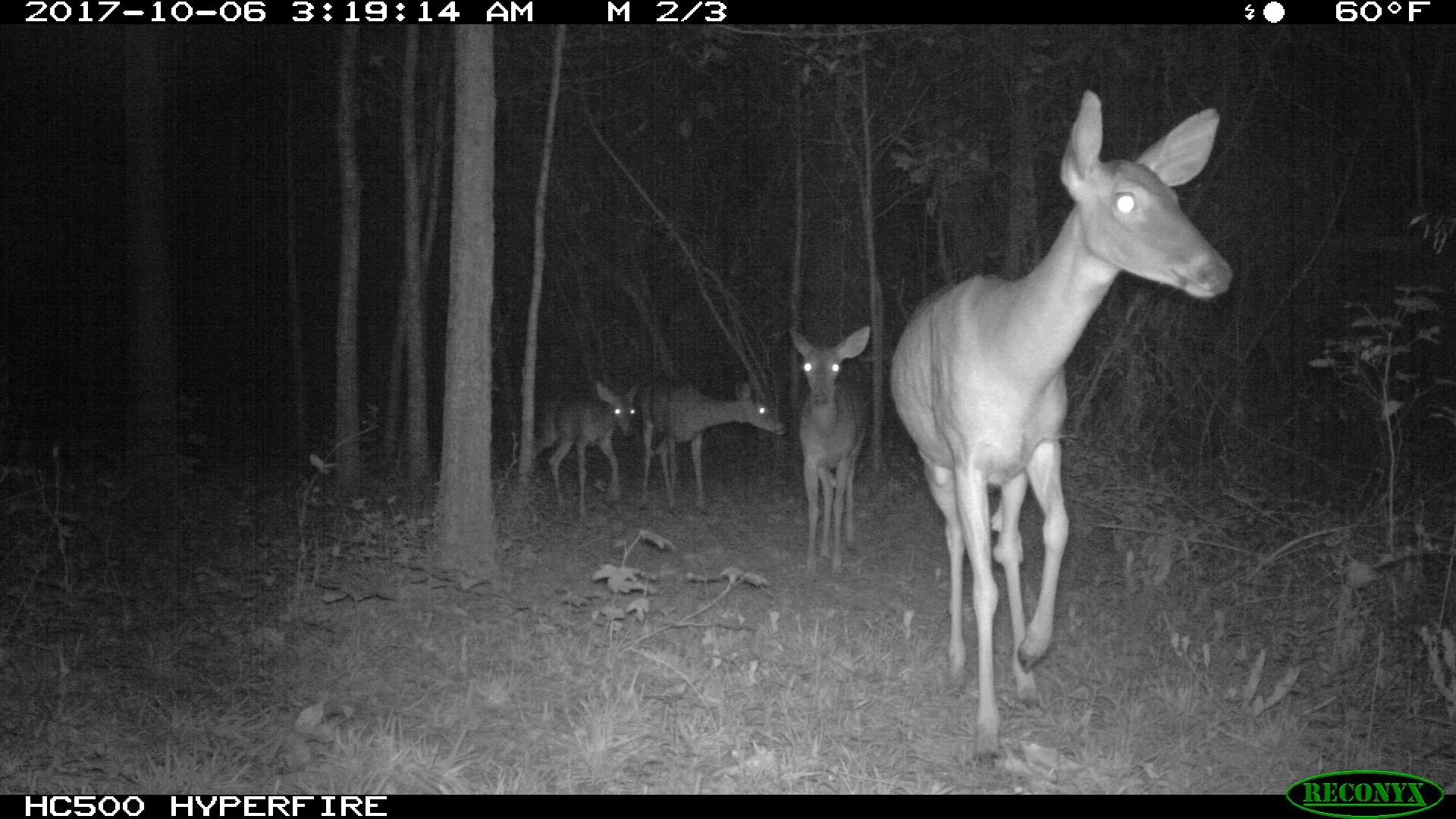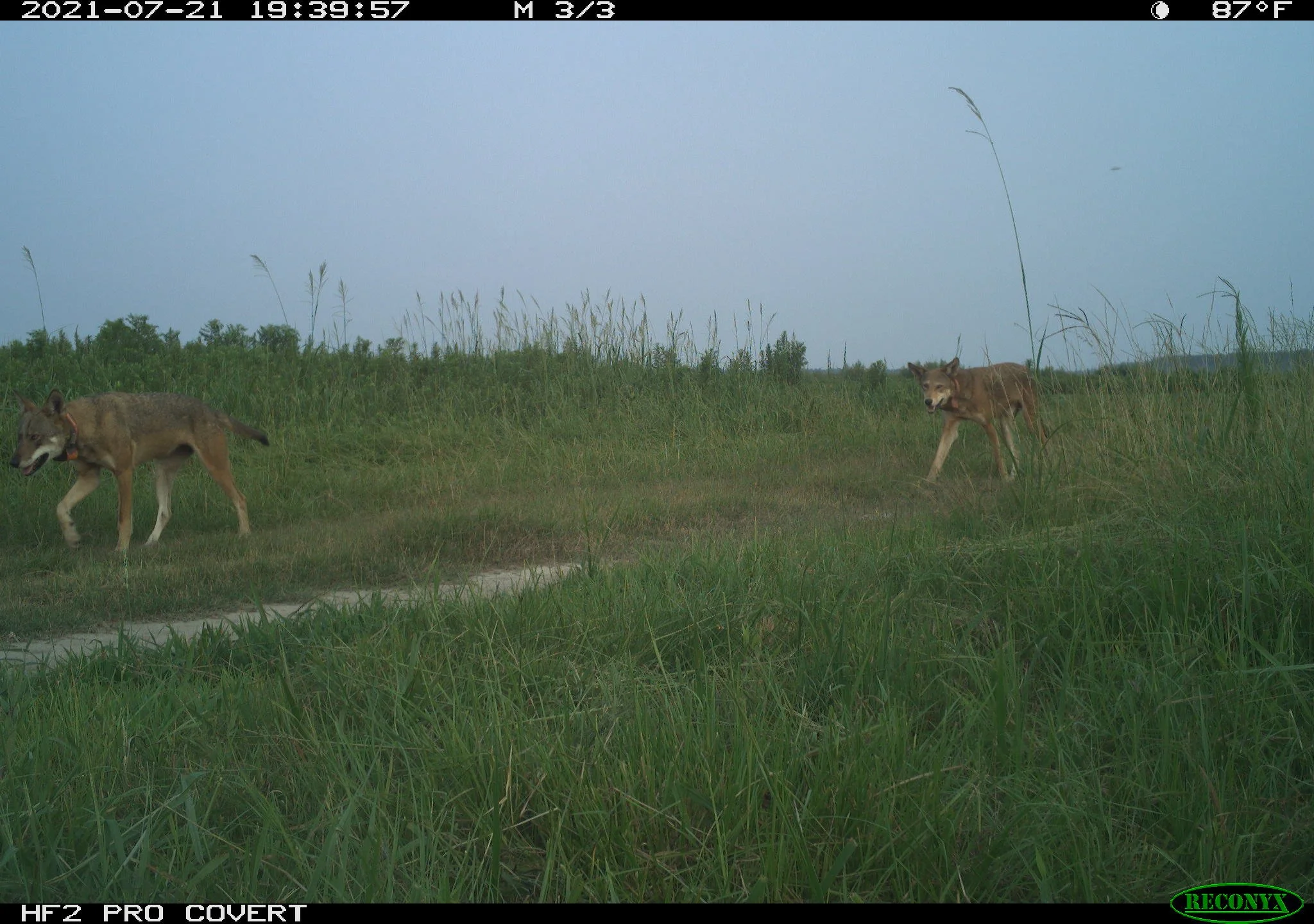Alexa Murray
1. You were the lead author on a study showing the ecological impacts of a declining Red Wolf population on the landscape in Eastern North Carolina. Can you walk us through the blueprint of this study related to the methods used and what the research team hoped to uncover in the years it took place from 2015-2021?
Starting in 2015, the team placed camera traps on trees about 0.5 meters (knee-height) off the ground and aimed them at nearby roads or trails. Cameras were placed at least 2 kilometers apart to ensure independent detections of individual animals. This keeps our relative abundance from getting over-inflated by counting an animal multiple times because it passed by several cameras. Two kilometers ensures independent detections for most prey species in this ecosystem. Once the images were retrieved and processed, we calculated detection rates for each species at each camera site.
This study aimed to address a gap in the knowledge of the ecological impacts of Red Wolves. There have been many studies looking at the behavior, ecology, and diet of Red Wolves, but none that have specifically looked at how their presence impacts the other species in the ecosystem. We wanted to evaluate the influence of these apex predators on the mammal community by using these camera trap data to determine trends in relative abundance of their prey and competitor species.
2. What strategies did you use to ensure successful monitoring of Red Wolves? What were some of the challenges in monitoring a declining population of Red Wolves who exist in a fairly large, five county area?
Red Wolves are very cryptic animals, so even using a noninvasive technique like camera trapping can be difficult. Not to mention that the population itself is very small, so there are fewer individuals to capture. To increase the chances of a target detection, cameras were put on game trails and were left out continuously, barring intermittent camera failure. Fortunately (or rather, unfortunately), the shrinking Red Wolf population had really consolidated into the Alligator River National Wildlife Refuge, making it a little easier for us to have their entire home range surveyed during this period.
3. With poaching being the leading cause of Red Wolf mortality during the population decline at the time, what were some of the misconceptions about Red Wolves that you hoped to dispel at the completion of this study?
The relationship between Red Wolves and deer was one that we were really interested in exploring, and one that is very important to the surrounding community. We weren’t sure what we would find, but we hypothesized that if the wolves had a strong ecological effect on the deer, then during their decline we would expect to see the relative abundance of deer to increase. While the average detection rate for deer did increase over the course of our study, it was not a statistically significant change and cannot be clearly explained by the wolf population. Additionally, the detection rates for deer remained high throughout the study and they were the second most commonly detected species on our cameras. Basically, there are a ton of deer in the area and the increase in their detection rates cannot be solely contributed to a declining wolf population.
4. What was revealed about the predator-prey relationship between Red Wolves and white-tailed deer along with other prey species during this research? How did a decline in the Red Wolf population affect other predators on the landscape like bears, coyotes, and bobcats, according to this study?
We found consistent increases in relative abundance for most prey and competitor species throughout the study, but that increase appeared more dramatic after spring 2018. Specifically, raccoons, opossums, bears, and bobcats showed a strong increase in relative abundance after that time. Deer showed a similar trend but had a unique sharp decline in relative abundance in the winter/spring of 2020, followed by an increase. Smaller prey species, such as rabbits and squirrels didn’t show any obvious trends. Gray fox also didn’t show any trends, but red fox (generally rare in our study) were the only species to show a (slightly) decreasing trend over time.
The large increase in raccoon relative abundance after the decline of Red Wolves is a great example of the mesopredator release hypothesis and supports the idea that coyotes don’t limit raccoon populations like wolves do. Interestingly, we saw an increase in relative abundance of opossums and turkeys, which are not known to be important food items for Red Wolves. It’s unclear if the increase in those populations is the result of changes in Red Wolf foraging or another factor. Because deer make up such a large proportion of the diet of Red Wolves, we were expecting the deer population to respond strongest to the wolf decline. While we did see an increase in their relative abundance throughout the study, the pattern was more variable than what was seen in other species. There was a dip in their relative abundance in winter/spring 2020 that cannot be explained by the wolf population. We suspect that the abundant bear population is obscuring any relationships we might see between wolves and deer.
Black bear were the most commonly detected species in our study, which is quite unusual. We were also surprised to see such a strong reaction from the bear population during this time. Given their smaller size, we were not expecting red wolves to directly compete with black bears in the same way that their larger cousins, gray wolves, do. As I mentioned earlier, we believe that the growing deer population has a stronger relationship with the bears than with the wolves, so we believe the deer are supplementing this protected bear population that also relies on planted crops on the refuge. The increase in the relative abundance of bobcats also suggests that there may be direct competition there, as both species rely heavily on rabbits as a source of food.
5. How can the information gathered during this study be used in conjunction with future studies? What future studies do you feel would be invaluable to the future of Red Wolf recovery?
First, and foremost, our results support continuation and expansion of the Red Wolf Recovery Program, as well as this specific camera trapping project. These data are invaluable for understanding how red wolves interact with their ecological communities. The importance of long-term camera trap monitoring for these data cannot be understated. This camera trap project could benefit from an expansion of the geographic scope of the project to better document the spatial variation and to include a control site for comparison. Future studies could also collect additional data to estimate densities of the entire mammal community. There are a lot of options moving forward to better document and understand these interactions.
6. In your experience working within the community that surrounds Red Wolf recovery, how does the importance of community support correlate with a successful recovery of this species?
Community support, or rather the lack thereof, can be detrimental to successful species recoveries. Having the community actively working against or opposing the recovery can create a myriad of legal and political roadblocks that are impossible for wildlife biologists to navigate. Community outreach and involvement early in the process can go a long way in earning their trust, and agency transparency is vital.
7. As a wildlife biologist, how did you become involved in the research surrounding the impacts Red Wolves have on the ecosystem? What lessons did you take away from the study you were involved in?
I’ve always been really interested in predators and how they interact with their communities. When I started grad school, I knew that I wanted to focus my research on that topic. I was fortunate enough to have Dr. Roland Kays take me under his wing and connect me with Dr. Ron Sutherland. Together, we looked at the 7-year data set that we had and came up with a question that we wanted to answer.
It's hard to look at the story of Red Wolves and find any silver linings. The population has been struggling since 2015 and it doesn’t seem to be getting any better. However, I have met people through this project that are tirelessly working to restore this species. Their passion and drive are contagious, and even in the face of these challenges, I can’t help but have hope for these amazing predators. It’s so gratifying to talk to people about Red Wolves and see the spark of curiosity in their eyes—for an animal they didn’t even know existed.
To read the published study, please visit the link below:
https://zslpublications.onlinelibrary.wiley.com/doi/full/10.1111/acv.12919















